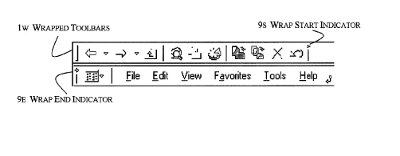Odom v. Microsoft, 2011-1160 (Fed. Cir. May 4, 2011) [PDF].
Inventor Odom sued Microsoft alleging that Microsoft infringed Odom’s U.S. Patent 7,363,592 directed to a method for manipulating groups of tools in toolbars in a computer software application. The district court found certain claims the of ‘592 patent invalid as obvious in view of U.S. Patent 6,057,836, stating that Odom had simply “cobbled together various pieces of what was already out there in a manner . . . that would have been obvious to anyone skilled in the art at the time of the invention.”  On appeal the Federal Circuit affirmed.
Claim 8 is a representative claim of the ‘592 patent:
8. A computer-implemented method comprising:
displaying a toolbar comprising at least one first tool group,
wherein said first tool group comprises at least one user-selectable tool,
wherein visibly designating said first tool group by at least one user-manipulatable divider located near at least one end of said first tool group,
wherein said first tool group divider is visually distinct from a said tool and from any visible means for directly manipulating said toolbar in its entirety, and
wherein said tool group divider is user-manipulatable for altering the condition of said tool group;
selecting said first tool group;
interactively tracking user indication of move-ment related to said first tool group until receiv-ing user indication to cease tracking; and
altering the condition of at least one tool group on said toolbar based upon said tracked user indica-tions.
Prior Art. The prior art ‘836 patent discloses “customizing a composite toolbar via direct on-screen manipulation by resizing the composite toolbar and by rearranging sections within a composite toolbar.” The ‘836 patent discloses toolbars that include “groups of command buttons. ” The toolbars can be modified by adding or deleting buttons or customizing buttons according to user preferences. The prior art patent further teaches that a toolbar can be collapsed or expended to allow the user to view as many or as few buttons as the user desires.
Manipulation on a Single Toolbar is Not New. The Federal Circuit found that the concepts claimed in the ‘592 patent were the same as those the ‘836 patent except that in the ‘529 patent the groups of tools were on a single toolbar. The court found that this was an insignificant advance over the  prior art ‘836 patent. The court noted that the prior art ‘826 patent explained, in the words of the court, “that although its invention has been described in the context of a web browser, employing collections of buttons and toolbars that are relevant to that application, a person of skill in the art would appreciate that the invention can be adopted to other application where a different arrangement or combination of tools may be desired.” Further the court found that it was only a trivial change for a person skilled in the art to add an indicator that could indicate any altered condition of the tool group, as was claimed in the ‘592 patent.